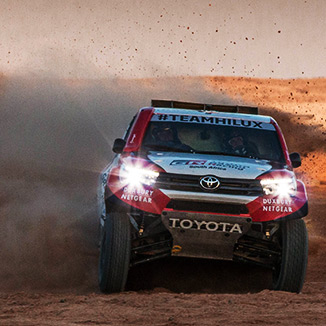DAKAR RALLY
ABOUT DAKAR RALLY
WHAT’S THE DAKAR RALLY
-
The Dakar Rally is the most famous and toughest rally raid in the world, racing across undeveloped terrain such as mountain passes, mud and desert. Driving upwards and over 900km a day, drivers and their vehicles are pushed to the limit. The rally tests their technique, mental/physical strength, mechanical skill and experience to cover nearly 9,000km in two weeks. The rally is so tough that it is said that “all drivers who complete the race are winners.” More than half of the vehicles that begin the race fail to finish it, epitomizing the toughness of the rally. The drivers, who come from over 50 countries, fight against the elements with the rally drawing around 4.4 million spectators with 70 television networks broadcasting worldwide.
-

TOYOTA’S HISTORY
IN THE RACE
Toyota has participated in the race since the beginning in 1979, with 13 of the 74 vehicles that finished being Toyota vehicles. Due to vehicles in the Production category of the race having harsh modification restrictions put upon them, their basic performance is incredibly important. Toyota’s durability and reliability has therefore made them a favorite for privateers in the race, with many using Toyota-made vehicles. For instance, in the 2017 race, 49% of the vehicles that finished were Toyotas.
TOYOTA GAZOO Racing South Africa first entered the Toyota Hilux in 2012 (under the name Imperial Toyota) where it has consistently finished within the Super Production top 10 since.
Team Land Cruiser Toyota Auto Body have been entering their Land Cruiser every year since 1995 (under the Team Araco name until 2004.)
For 22 years, they have entered the rally race with several Land Cruisers including the 80, 100 and 200 series with massive success. The team has accrued 16 wins out of 22 races including a 1st and 2nd place finish in the Production category in 2017.
HISTORY OF THE DAKAR RALLY
In 1978 Thierry Sabine founded the first Dakar Rally as a race across the Sahara Desert where competitors could compete in anything as long as it had an engine and wheels. Sabine was inspired to create the Dakar Rally after he found himself lost in the desert, in a separate race the year before. In 1979, the Dakar Rally took its current form with a three-week-long race beginning in Paris and ending in Dakar. The rally was officially certified by the FIA (Fédération Internationale de l'Automobile) in 1981 and firmly established itself in the world of motorsports.
The rally remained in North Africa until 2008 when the rally was cancelled due to growing safety concerns. This acted as the catalyst to move the rally to South America which held its first race in 2009. The location may be different but the name and spirit of the event remain unchanged.